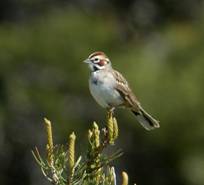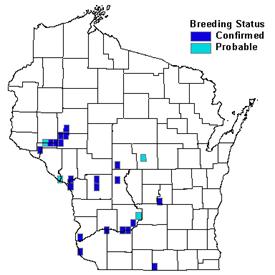Photo by Steve Zack


Status/Protection
- Global Rank: G5 Key to global and state ranks
- State Rank: S2B
- WBCI Priority: SGCN, State Special Concern
Population Information
Federal BBS information can be obtained at http://www.mbr-pwrc.usgs.gov/bbs/bbs.html by clicking on Trend Estimates and selecting the species in question. All estimates are for 1966-2005.
*Note: There are important deficiencies with these data. These results may be compromised by small sample size, low relative abundance on survey route, imprecise trends, and/or missing data. Caution should be used when evaluating this trend.
- Federal Breeding Bird Survey: significant decrease
- Federal Breeding Bird Survey (WI): increase*
- Federal Breeding Bird Survey (BCR 23): increase*
- Federal Breeding Bird Survey (BCR 12): N/A
- WSO Checklist Project: increasing (1983-2007)
Life History
- Breeding Range: Mississippi River westward to California coast (Martin and Parrish 2000).
- Breeding Habitat: Dry Prairie, Sand Barrens, Fallow Field, Idle Cool-season Grasses, Grassland-shrub, Pine Barrens, Row Crop.
- Nest: Ground or in tree or shrub up to 2.75 m from ground.
- Nesting Dates: Eggs: early May to early July.
- Foraging: Ground glean.
- Migrant Status: Short-distance migrant.
- Habitat use during Migration: Little information, but likely similar to breeding habitat.
- Arrival Dates: Late April.
- Departure Dates: Mid-August to mid-September.
- Winter Range: Southern U.S. to Central America.
- Winter Habitat: Little information. Similar to breeding habitat.
Habitat Selection
Lark Sparrows prefer sites with bare soil or sand blows and short, sparse herbaceous vegetation (Sample and Mossman 1997). In Wisconsin this species is a specialist of oak barrens and sand prairies, but it also occurs in short idle grasslands, farmlands, Grassland-shrub, and pastures (Sample and Mossman 1997, Martin and Parrish 2000). These habitats typically, but not always, have scattered shrubs and trees (Sample 2006). Ground nests often are placed at the base of an herbaceous or woody plant (Martin and Parrish 2000). Lark Sparrows will nest in moderately to heavily grazed pasture lands (Lusk et al. 2003).
Habitat Availability
Existing parcels of sand prairie and oak barren habitats in the state are few, and those remaining are vulnerable to fragmentation, row crop conversion, urban development, and forest succession. Idle grassland and Grassland-shrub habitats also are uncommon and subject to the same threats. The Lark Sparrow’s range in Wisconsin is restricted to those regions where the soil is too sandy for agriculture, where grass is short and sparse and interspersed with Hill’s oak and jack pine (Robbins 1991).
Population Concerns
The Lark Sparrow was apparently irregularly distributed but common historically in Wisconsin (Sample 2006). The conversion of many of the state’s upland prairies to agriculture corresponded with a range contraction. The Lark Sparrow is now considered an uncommon summer resident in the western and central regions of the state (Robbins 1991). During the six-year period (1995-2000) of the Wisconsin Breeding Bird Atlas, observers recorded Lark Sparrows on only 2.5% of Atlas blocks, with breeding confirmed on three-quarters of those quads (Sample 2006). Breeding Bird Survey data suggest an increasing population trend in Wisconsin (Sauer et al. 2005). However; this species is found on very few routes and the corresponding population trend is very imprecise. Range-wide trends suggest a significant decline (Sauer et al. 2005) and are probably a better representation of the true population status.
Recommended Management
Management for this species should focus on maintaining short (<15cm), sparse herbaceous vegetation with a high grass:forb ratio, high percentage of bare ground, and <5% woody cover (Sample and Mossman 1997). Lark Sparrows typically respond positively to prescribed burning and will quickly colonize recently burned areas that maintain some woody cover (Dechant et al. 1999, Martin and Parrish 2000). Lark Sparrows also respond positively to grazing, preferring moderate to heavy grazed fields over ungrazed fields (Martin and Parrish 2000).
Conservation and management strategies for this species should be focused in the following Wisconsin ecological landscapes: Central Sand Hills, Central Sand Plains, Northeast Sands, Southeast Glacial Plains, and Western Coulee and Ridges (WDNR 2005). Within these landscapes, important areas for the management of Lark Sparrow include Fort McCoy Military Reservation, Lower Wisconsin River Prairies and Barrens, and Lower Chippewa River Savannas and Prairies (Sample and Mossman 1997).
Research Needs
Research needs for this species are numerous. The Lark Sparrow has largely been overlooked and poorly studied. Research into the Lark Sparrow’s natural history, ecology, and habitat preferences is warranted to facilitate more effective management (Martin and Parrish 2000).
Information Sources
- Knutson, M.G., G. Butcher, J. Fitzgerald, and J. Shieldcastle. 2001. Partners in Flight Bird Conservation Plan for The Upper Great Lakes Plain (Physiographic Area 16). USGS Upper Midwest Environmental Sciences Center in cooperation with Partners in Flight. La Crosse, WI.
- Managing Habitat for Grassland Birds: A Guide for Wisconsin: http://www.npwrc.usgs.gov/resource/birds/wiscbird/
- North American Breeding Bird Survey: http://www.npwrc.usgs.gov
- Temple S.A., J.R. Cary, and R. Rolley. 1997. Wisconsin Birds: A Seasonal and Geographical Guide. Wisconsin Society of Ornithology and Wisconsin Department of Natural Resources, Madison, WI.
- Wisconsin Breeding Bird Atlas: http://www.uwgb.edu/birds/wbba/
- David Sample, Grassland Community Ecologist, Wisconsin DNR - 608-221-6351.
References
- Martin, J.W., and J.R. Parrish. 2000. Lark Sparrow (Chondestes grammacus). In the Birds of North America, No. 488 (A. Poole and F. Gill, eds.). The Birds of North America, Inc., Philadelphia, PA.
- Robbins, S.D., Jr. 1991. Wisconsin Birdlife: Population and distribution past and present. Madison, WI: Univ. Wisconsin Press.
- Sample, D. and M. Mossman. 1997. Managing Habitat for Grassland Birds: A Guide for Wisconsin. Wisconsin Department of Natural Resources: Madison, WI.
- Sample, D. 2006. Lark Sparrow. In Atlas of the Breeding Birds of Wisconsin. (N. Cutright, B. Harriman, and R. Howe, eds.) The Wisconsin Society for Ornithology, Inc. 602pp.
- Sauer, J. R., J. E. Hines, and J. Fallon. 2005. The North American Breeding Bird Survey, Results and Analysis 1966 - 2004. Version 2005.2. USGS Patuxent Wildlife Research Center, Laurel, MD.
- Wisconsin Department of Natural Resources (WDNR). 2005. Wisconsin’s Strategy for Wildlife Species of Greatest Conservation Need. Madison, WI.
Contact Information
- Compiler: Jenny Herrmann, mherrmann4@wi.rr.com
- Editor: Kim Kreitinger, K.Kreitinger@gmail.com
